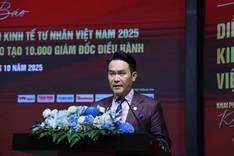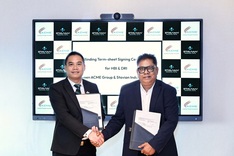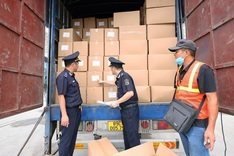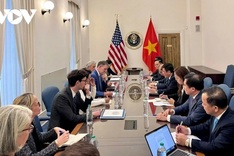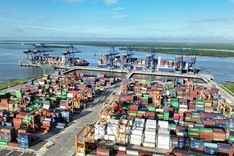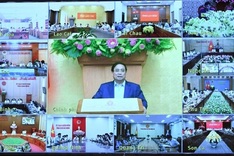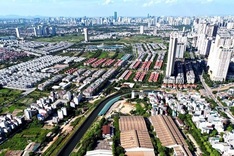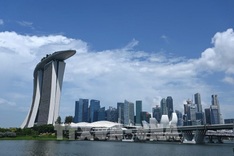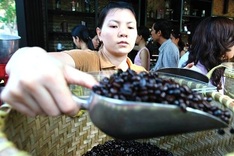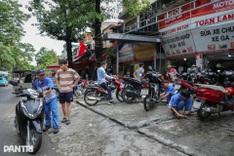 Both urban and rural areas of Vietnam offer growth prospects, as the country's insurance sector enters its second decade of development, according to Manulife (Vietnam) Ltd.
Both urban and rural areas of Vietnam offer growth prospects, as the country's insurance sector enters its second decade of development, according to Manulife (Vietnam) Ltd.
In the past decade, Manulife Vietnam, a unit of Manulife Financial Corp., focused on business development for the middle-class segment in urban areas. This segment remains the "core competency" of the insurer's life business, said David Wong, chief executive of Manulife Vietnam. But the countryside is ripe with opportunities.
The Rural Challenge
In Vietnam, about three-quarters of the population live in rural areas, while agriculture accounts for 22% of the country's gross domestic product and 55.6% of the total labor force, according to the U.S. Central Intelligence Agency's World Factbook.
Agriculture is a very permanent sector in Vietnam, given the country's rich farming resources, noted Wong. Unlike the demographic trend in North America, not everyone can ultimately enter the middle class in Southeast Asian countries. "The rural population is going to be a huge market segment in Vietnam," said Wong.
"Micro-insurance is not micro [in this part of the region]," said Wong in an interview. A rethinking of insurance strategy is necessary for an emerging market that has its own distinctive social structure and development.
In most markets, insurance development is usually geared toward the middle-class segment. But insurance can also be made available for low-income groups, said Wong.
Insurers require a different mind-set to design an appropriate model in underwriting, profitability, distribution, claims management and premium collection for micro-insurance, said Wong. In Vietnam, micro-insurance products have a premium rate of about US$20 per year, and claim capacity is about US$1,000.
Last September, Manulife Vietnam initiated a micro-insurance project in Hai Phong and Tien Giang, in cooperation with a nonprofit organization, Vietnam Women's Union. The rural project acquired new policies from nearly 16,000 women union members.
Manulife Vietnam is looking to build up this rural customer base to 500,000 to 600,000 policyholders in the future, said Wong. It is anticipated that 10% of these policyholders may emerge as a higher income group, who could then purchase a regular insurance policy.
Micro-insurance is "financially justified" and not just a charity concept, said Wong. The crux is to master an appropriate business and distribution model. The product offers protection against accidents, financial and climate-related risks for the rural population.
Traditional agent distribution is not a cost-effective channel to facilitate rural penetration. In promoting micro-insurance, Wong said partnerships with nonprofit or social institutions are essential to reach villages with adequate administrative support. Training is given to the administrative staff of the nonprofit organization.
Market Evolution
Vietnam has a promising life insurance market as its young demographic structure offers attractive growth potential, according to Wong. The emergence of a middle class has created prefect timing for life insurance business.
With a population of about 88 million, Vietnam's median age stands at 27.4 years, according to the CIA Factbook.
In 2008, Vietnam's insurance industry generated 21.3 trillion dong (US$1.2 billion) in premiums, up 20.4% from the previous year's 17.7 trillion dong. With one local and 10 foreign insurers, the life sector saw a 9.2% rise in premiums to 10.3 trillion dong, according to Swiss Re's [85010] world insurance sigma report.
Life insurance has an "optimistic" business outlook, and the market is expected to continuously post double-digit growth, said Wong. Manulife Vietnam achieved 60% and 30% premium growth in 2007 and 2008, respectively. In the first nine months of 2009, the insurer saw 24% growth in premiums.
Vietnam's three largest life insurers in 2008 were U.K-based Prudential plc [85925] with 4.27 trillion dong in premiums; domestic insurer Bao Viet with 3.4 trillion dong; and Manulife with 1.07 trillion dong, according to the Ministry of Finance. The life insurance sector is expected to see annual growth of 8% to 10% through 2010.
The country's life and nonlife insurance penetration [premiums as a percentage of GDP] stood at 0.7% and 0.74%, respectively, in 2008, according to Swiss Re's sigma report. Similar to other emerging markets, Vietnam is working to develop infrastructure, legal and regulatory frameworks.
Vietnam is still a "frontier market," experiencing various "ups and downs" in its development, said Wong. Since the opening of insurance market a decade ago, insurers have been creating and promoting the industry from scratch.
Insurance regulation is still young in Vietnam, as the regulator and insurers are working together on its development. Basically, Vietnam's regulatory regime adopts the risk-based capital model. A foreign insurer is allowed to have a wholly owned company without restrictions on branch operations. Vietnam now has 11 life insurers, 27 nonlife insurers, one reinsurer and 10 brokers.
The capital requirement for life insurance companies stands at US$37.5 million, after the regulator raised the standard a few years ago prior to the country's accession into the World Trade Organization. The requirement is relatively high compared with the insurance market's size, noted Wong.
Looking to the next decade, Wong noted market development will be determined by complex factors under the influence of fast economic growth, increasing numbers of foreign players, a rising middle class, emerging consumerism and growing GDP. Fundamental Asian elements such as high savings rates and an emphasis on education should contribute to insurance market growth.
Product demand has been traditional, with a majority of policies in endowment insurance. However, investment-linked and health insurance products are becoming more popular. This product trend is evolving with a rising middle class and market sophistication, noted Wong. Eventually, development will include retirement and long-term care protection products.
Insurance distribution is dominated by agents, while bancassurance is just taking off as an alternative channel. As less than 10% of the population has a bank account, bancassurance has not yet been developed in Vietnam.
Manulife Vietnam has 95% of its insurance distribution through sales agents, said Wong. With 300,000 customers, the Canadian insurer has 5,500 agents. It also has distribution partnerships with Asia Commercial Bank and Techcombank so as to broaden product offerings to the middle class.
In September 1999, Manulife entered Vietnam with the establishment of a joint-venture company, Chinfon-Manulife Insurance Co., and received a foreign investment license three months later. Manulife Vietnam became a wholly foreign-owned insurance company in 2001. Manulife Vietnam was approved to set up a fund management subsidiary, Manulife Vietnam Fund Management, in June 2005.
Manulife seeks dual-track growth in Vietnam's urban and rural areas
Both urban and rural areas of Vietnam offer growth prospects, as the country's insurance sector enters its second decade of development, according to Manulife Vietnam.
Source: dtinews.vn



